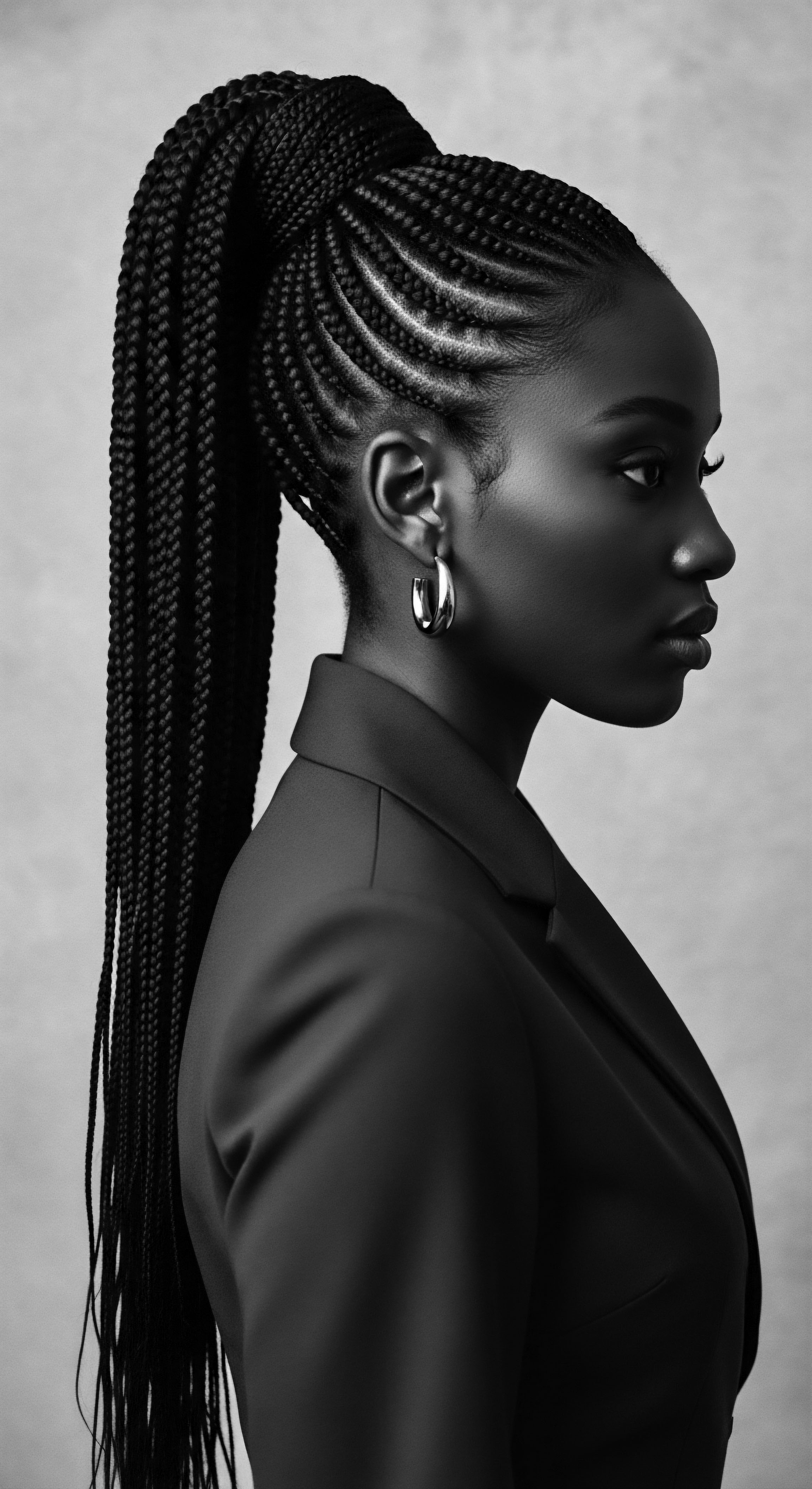
Fundamentals
The ancient wisdom of the earth whispers tales through its botanicals, and among these, Black Seed Oil, extracted from the unassuming seeds of the Nigella Sativa plant, stands as a venerable elder. Its elemental definition is deceptively simple ❉ a potent oil pressed from tiny, dark seeds, often referred to as black cumin or kalonji. This humble botanical, with roots tracing back millennia, embodies a profound understanding of nature’s restorative capacities.
For communities whose lives were intricately tied to the rhythms of the land, this oil was not merely an ingredient; it was a revered gift, a symbol of life’s enduring strength. Its significance, a profound sense of purpose, was understood not through laboratory analysis but through generations of careful observation and intuitive application.
The very name, Nigella Sativa, carries echoes of its origins in Southwestern Asia, the Middle East, and North Africa, regions where its cultivation has been a cornerstone of traditional medicine and daily life for thousands of years. From the sun-drenched plains of Egypt to the vibrant markets of the Levant, the seed and its oil held a special place in ancient healing traditions, including Ayurvedic, Unani, and Islamic medicine. It was known as “Habbat al-Barakah” in Arabic, translating to the “Seed of Blessing,” a designation that speaks volumes about the deep respect and spiritual reverence it commanded. This designation extends beyond mere medicinal use, encompassing its role in rituals and daily wellness practices.
The Black Seed Oil, a venerable essence from the Nigella Sativa plant, is a testament to ancient wisdom, deeply woven into the heritage of communities across continents.

Echoes from the Source ❉ Ancient Lineages of Care
The earliest documented encounters with Black Seed Oil reveal its foundational meaning as a panacea, a universal healer for various ailments. Historical accounts and archaeological findings place its use firmly in the cradle of civilization. Seeds of Nigella Sativa were discovered in the tomb of Tutankhamun, emphasizing their ceremonial and medicinal importance to the pharaohs, suggesting a belief in its protective and restorative qualities even in the afterlife.
Queens like Nefertiti and Cleopatra, renowned for their legendary beauty, reportedly incorporated this oil into their personal care regimens, recognizing its capacity to enhance skin and hair vitality. This historical thread highlights its initial role not just in physical well-being, but in the expression of status and beauty within these ancient societies.
The application of Black Seed Oil for hair care in these early contexts was intuitive. It was understood that a nourished scalp provided the groundwork for robust hair, and the oil’s rich, fatty consistency offered protection and moisture. Traditional methods involved warming the oil gently and massaging it into the scalp, a practice that stimulated circulation and aided in the delivery of its beneficial compounds.
This ritualistic approach to hair care, often performed communally, established a blueprint for holistic well-being that intertwined physical care with communal bonding and spiritual connection. The very act of preparing and applying the oil became a tender moment, a quiet acknowledgment of the body as a vessel for ancestral memory and identity.
The inherent properties of the oil, such as its ability to soothe and cleanse, were observed and passed down through oral traditions long before modern science could delineate its chemical composition. Its mild aroma and a slight peppery taste were markers of its authenticity and potency. The early delineation of Black Seed Oil, therefore, rests on its perceived capacity to restore balance, whether to the body’s internal systems or to the external landscape of skin and hair. This deep-seated perception, rooted in centuries of empirical use, forms the bedrock of its enduring presence in textured hair care today.

Intermediate
Moving beyond its fundamental identity, the Black Seed Oil gains a deeper meaning through its journey across time and cultures, particularly within the living heritage of textured hair care. Its practical applications, passed down through generations, speak to its enduring relevance. This oil has consistently served as a tender thread, linking ancestral practices to contemporary routines, adapting to the unique needs of Black and mixed-race hair textures. Its significance within these traditions is not static; it reflects an ongoing dialogue between ancient wisdom and evolving care rituals.
The understanding of Black Seed Oil for textured hair care centers on its capacity to address specific challenges, such as dryness, breakage, and scalp irritation, common concerns for hair with intricate curl patterns. Ancestral communities, lacking modern scientific tools, relied on keen observation and empirical results. They recognized the oil’s ability to soften hair, reduce shedding, and promote a healthy scalp environment. This knowledge was not merely transmitted as instructions; it was embodied in shared experiences, in the hands that braided, twisted, and massaged, carrying the collective memory of hair resilience.

The Tender Thread ❉ Continuity of Care Through Generations
Within the African diaspora, the ritual of “wash day” or communal hair care sessions became a sacred space where traditions were reaffirmed and knowledge exchanged. In these settings, Black Seed Oil, or its conceptual equivalents from local flora, played a vital role. It served as a fortifying treatment, often warmed and massaged into the scalp before cleansing, or applied as a sealing oil to retain precious moisture after washing. This practice, while seemingly simple, was a profound act of self-preservation and cultural affirmation, especially in contexts where Black hair was often devalued or misunderstood.
The journey of Black Seed Oil through textured hair heritage reveals its dynamic adaptation, a constant interplay between ancestral wisdom and contemporary care.
The application of Black Seed Oil, sometimes blended with other traditional ingredients like shea butter or coconut oil, became a testament to ingenuity and resourcefulness. These blends were crafted to provide intense hydration, fortify strands against environmental stressors, and soothe the scalp. The oil’s intrinsic properties, later understood as anti-inflammatory and antioxidant due to compounds like thymoquinone, were experienced as a calming sensation, a reduction in itchiness, and a visible improvement in scalp health. This practical wisdom, honed over centuries, highlights the deep intuitive connection between people and the plants that sustained them.
Consider the practices of the Yoruba people of Nigeria, where hair care, known as “Irun Kiko,” was considered as important as the head itself, believed to bring good fortune. While specific historical records directly linking Nigella Sativa to these exact rituals are scarce, the underlying principles of using natural oils for hair health, protection, and length retention were widely practiced across various African cultures. The continuity of these principles, even with ingredient variations based on regional availability, underscores a shared heritage of valuing and nurturing textured hair. The oil’s gentle yet potent nature made it a preferred choice for delicate strands, minimizing breakage and promoting a healthy environment for growth.
| Traditional Application Scalp Massage for general wellness and hair vitality. |
| Contemporary Relevance for Textured Hair Pre-Poo Treatment ❉ Applied to the scalp and hair before washing to protect strands and nourish the scalp. |
| Traditional Application Hair Oiling to protect from elements and add luster. |
| Contemporary Relevance for Textured Hair Sealing Oil ❉ Used on damp hair after moisturizing to lock in hydration and enhance shine. |
| Traditional Application Herbal Infusions with other botanicals for specific concerns. |
| Contemporary Relevance for Textured Hair DIY Hair Masks ❉ Blended with ingredients like aloe vera, honey, or other natural oils for targeted treatments. |
| Traditional Application Protective Styling Prep for braiding and twisting. |
| Contemporary Relevance for Textured Hair Styling Aid ❉ Applied to strands before braiding or twisting to provide slip, reduce friction, and add nourishment. |
| Traditional Application These applications reveal a continuous thread of care, adapting ancient wisdom to modern needs while honoring the intrinsic value of textured hair. |

Academic
The advanced definition of Black Seed Oil, or Nigella Sativa, transcends its historical uses to encompass a sophisticated understanding of its complex phytochemistry and its profound implications for textured hair heritage. This is not merely an oil; it is a botanical lexicon, a statement of ancestral ingenuity validated by contemporary scientific inquiry. Its true meaning unfolds at the intersection of biological science, cultural anthropology, and the lived experiences of Black and mixed-race communities.
From a scientific perspective, the efficacy of Black Seed Oil is largely attributed to its primary active compound, Thymoquinone (TQ). This powerful antioxidant and anti-inflammatory agent is responsible for many of the oil’s reputed benefits for hair and scalp health. Thymoquinone acts on various cellular pathways, helping to mitigate oxidative stress and reduce inflammation, both of which are common culprits behind hair loss and scalp conditions prevalent in textured hair. The intricate structure of textured hair, with its unique curl patterns and susceptibility to dryness and breakage, benefits significantly from compounds that can fortify the hair shaft and maintain a healthy scalp microenvironment.

Unbound Helix ❉ Scientific Validation and Cultural Affirmation
The exploration of Black Seed Oil’s impact on hair density provides a compelling case study. A 2013 study, involving 20 women experiencing Telogen Effluvium—a temporary form of hair shedding often triggered by stress or illness—revealed significant improvements. Participants who used a lotion containing 0.5 percent Black Seed Oil showed noticeable increases in hair density and thickness. This finding is particularly salient for Black and mixed-race hair experiences, where hair loss and thinning can carry profound psychological and social weight, often compounded by historical narratives that devalued textured hair.
The study, while small, offers a scientific affirmation of the ancestral belief in the oil’s restorative powers, suggesting that traditional practices were grounded in observable, beneficial outcomes. Further research indicates that 70% of individuals with telogen effluvium experienced a reduction in hair thinning with the use of black seed oil, as it appears to prevent hair follicles from prematurely entering the resting phase and soothes scalp inflammation.
The complexity of Black Seed Oil extends beyond thymoquinone. It contains a rich array of fatty acids, including Oleic Acid, Linoleic Acid, and Palmitic Acid, alongside vitamins (A, B, C, E), minerals (calcium, phosphorus, iron, zinc, copper), and amino acids. These constituents work in concert, contributing to the oil’s multifaceted benefits.
Oleic acid, naturally present in the hair’s hydrolipidic film, acts as a protective shield against external aggressions, while palmitic acid contributes to the cuticle’s integrity, strengthening the hair fiber. This comprehensive profile elucidates why ancient cultures revered it as a holistic remedy, recognizing its capacity to nourish and protect from within and without.
From an anthropological viewpoint, the consistent presence of Nigella Sativa in diverse healing and beauty traditions points to a shared, ancestral knowledge system that recognized the symbiotic relationship between humans and their natural environment. The oil’s historical use in regions with predominantly textured hair populations is not coincidental; it speaks to its specific suitability for the unique structural and physiological needs of these hair types. The collective memory of its efficacy, passed down through generations, constitutes a powerful cultural artifact, a living testament to resilience and adaptation.
The enduring pertinence of Black Seed Oil in the modern landscape of textured hair care signals a reclamation of ancestral practices. It is a statement that traditional wisdom, often dismissed in favor of synthetic solutions, holds valuable insights for contemporary well-being. Its ongoing evolution in commercial products, from hair masks to serums, signifies a renewed appreciation for its heritage-rich profile. The oil becomes a conduit, connecting individuals to a lineage of care that affirms the beauty and strength of textured hair, celebrating its unique identity and shaping its future.
- Thymoquinone (TQ) ❉ The primary active compound, recognized for its potent antioxidant and anti-inflammatory properties, playing a central role in scalp health and mitigating hair loss. Its historical use in traditional medicine, though not always explicitly linked to this molecule, demonstrated its calming and restorative effects on the body.
- Oleic Acid ❉ A monounsaturated fatty acid that mirrors components of the hair’s natural protective layer, contributing to moisture retention and environmental defense. Ancestral users would have observed the oil’s ability to soften and shield hair, a testament to this fatty acid’s action.
- Linoleic Acid ❉ An essential polyunsaturated fatty acid that supports the overall health of hair follicles and contributes to hair strength and flexibility. Its presence in the oil likely contributed to the historical perception of Black Seed Oil as a fortifying agent for delicate strands.
- Palmitic Acid ❉ A saturated fatty acid with a structure akin to the lipids in the hair cuticle, aiding in the restoration and cohesion of the hair’s outer layer, thus enhancing its impermeability and internal protection. This property explains the historical observation of increased shine and reduced breakage.
- Vitamins (A, B, C, E) and Minerals (Iron, Zinc, Copper, Phosphorus, Calcium) ❉ A spectrum of micronutrients that provide essential nourishment for healthy hair growth and overall scalp vitality. These elements underpin the oil’s traditional reputation as a comprehensive hair tonic.
The intricate chemistry of Black Seed Oil, particularly Thymoquinone, scientifically validates centuries of ancestral application, proving its capacity to fortify textured hair.
The application of Black Seed Oil in the context of specific hair conditions, such as Alopecia Areata or Psoriasis, which can disproportionately affect textured hair, finds grounding in its immunomodulatory and anti-inflammatory actions. While anecdotal evidence has long supported its use, modern research is beginning to provide a scientific basis for these traditional claims. This convergence of ancient knowledge and contemporary investigation strengthens the understanding of Black Seed Oil not just as a natural remedy, but as a culturally significant botanical with tangible, measurable benefits for textured hair. The ongoing discourse surrounding its properties continues to shape its meaning, solidifying its standing as a vital component in the holistic care of textured hair.

Reflection on the Heritage of Black Seed Oil
As we close this exploration of Black Seed Oil, its presence within Roothea’s living library stands as a profound testament to the enduring power of ancestral wisdom. This remarkable botanical, often referred to as the “Seed of Blessing,” is far more than a simple oil; it is a living chronicle, a resonant whisper from generations past that speaks directly to the soul of every strand. Its journey from ancient hearths and royal chambers to the contemporary landscape of textured hair care exemplifies a continuous thread of resilience, adaptation, and unwavering self-affirmation.
The story of Black Seed Oil is inextricably linked to the heritage of Black and mixed-race hair. It mirrors the very experiences of these communities ❉ rooted in deep history, often misunderstood or undervalued, yet possessing an inherent strength and a capacity for profound beauty. The rituals of applying this oil, whether in communal settings or private moments of self-care, transcend mere cosmetic acts.
They become ceremonies of connection, reinforcing a sense of belonging to a lineage that honored hair as a sacred extension of identity and spirit. This connection offers a grounding presence, a reminder that the path to vibrant hair health is often found by looking back to the wisdom that sustained our forebears.
In every drop of Black Seed Oil, we find an echo of the hands that first pressed its seeds, the voices that shared its benefits, and the spirits that found solace in its touch. It is a reminder that true wellness stems from a harmonious relationship with nature and a deep reverence for the knowledge passed down through time. As we continue to unravel the complexities of textured hair, Black Seed Oil stands as a beacon, illuminating the path forward by honoring the richness of our shared past, allowing the unbound helix of heritage to continue its beautiful, powerful expression.

References
- Ahmad, A. Husain, A. Mujeeb, M. Khan, S. A. Najmi, A. K. Siddique, N. A. Damanhouri, Z. A. & Anwar, F. (2013). A review on the therapeutic potential of Nigella sativa ❉ A miracle herb. Asian Pacific Journal of Tropical Biomedicine, 3(5), 337–352.
- Al-Jassir, M. S. (1992). Chemical composition and quality traits of some Nigella sativa L. seed accessions grown in Saudi Arabia. Food Chemistry, 45(4), 235-240.
- Ali, B. H. & Blunden, G. (2003). Pharmacological and toxicological properties of Nigella sativa. Phytotherapy Research, 17(3), 299-305.
- Goreja, W. G. (2003). Black Seed ❉ Nature’s Miracle Herb. Amazing Herbs Press.
- Kukreja, R. C. & Dhalla, A. K. (1994). Cardioprotective effects of Nigella sativa oil in isoproterenol-induced myocardial injury in rats. Molecular and Cellular Biochemistry, 131(1), 71-77.
- Randhawa, M. A. (2012). Nigella Sativa (Black Seed) an Unani Perspective. Journal of Health Sciences, 2(1), 10-15.
- Shah, Z. A. & Khan, R. A. (2012). Phytochemical and pharmacological studies on Nigella sativa – A review. Journal of Pharmacy Research, 5(1), 32-38.
- Shashikanth, S. & Harini, K. (2016). A review on the cosmeceutical and external applications of Nigella sativa. Journal of Ayurveda and Holistic Medicine, 4(1), 30-34.
- Tiwari, R. & Singh, R. K. (2015). Nigella sativa Linn. ❉ A comprehensive review on its pharmacological and therapeutic properties. International Journal of Pharmaceutical Sciences and Research, 6(11), 4642-4652.
- Zaoui, A. Cherrah, Y. Lacaille-Dubois, N. A. Settaf, A. & Hassar, H. (2000). Diuretic and hypotensive effects of Nigella sativa in conscious rats. Life Sciences, 67(8), 953-960.
